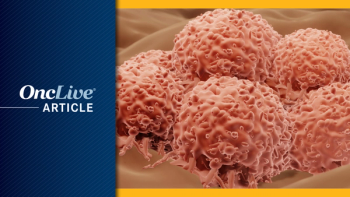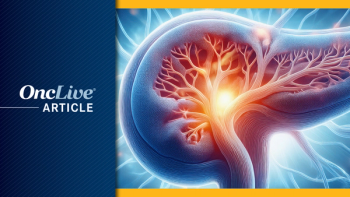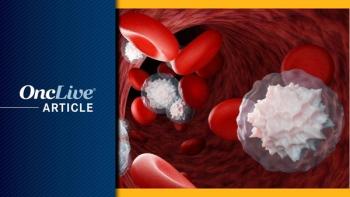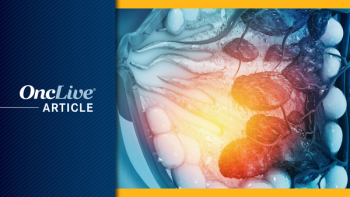
Pevonedistat Plus Ibrutinib Showcases Preliminary Efficacy and Tolerability in CLL and MCL

The investigational NEDD8-activating enzyme inhibitor pevonedistat in combination with ibrutinib demonstrated high response rates with a tolerable safety profile in patients with relapsed/refractory chronic lymphocytic leukemia and mantle cell lymphoma.
The investigational NEDD8-activating enzyme inhibitor pevonedistat in combination with ibrutinib (Imbruvica) demonstrated high response rates with a tolerable safety profile in patients with relapsed/refractory chronic lymphocytic leukemia (CLL) and mantle cell lymphoma (MCL), according to findings from a phase 1 trial (NCT03479268) that were presented during the 2021 International Workshop on CLL.1
Across all patients treated (n = 18), the overall response rate (ORR) was 65% with the combination of pevonedistat and ibrutinib; the responses consisted of 4 complete responses (CRs) and 7 partial responses (PRs).
In patients with MCL (n = 8), the ORR was 100%; the responses consisted of 3 CRs and 5 PRs. In patients with CLL, small lymphocytic lymphoma, or B-cell prolymphocytic leukemia (B-PLL; n = 4), the ORR was 50%; the responses consisted of all PRs.
Notably, the recommended phase 2 dose of pevonedistat was confirmed at 50 mg/m2.
“The study demonstrates the safety of the combination of pevonedistat and ibrutinib in patients with B-cell malignancies,” said principal study investigator Alexey Danilov, MD, PhD, associate director of the Toni Stephenson Lymphoma Center and a professor in the Division of Lymphoma of the Department of Hematology & Hematopoietic Cell Transplantation at City of Hope. “Targeting neddylation, as achieved with pevonedistat, is of interest in lymphoid malignancies, particularly in the context of recent discoveries of its immunomodulatory effect.”
Although treatment advances have improved outcomes for patients with non-Hodgkin lymphoma, treatment in the relapsed/refractory setting remains an unmet need.
Pevonedistat is a first-in-class, selective, small molecule inhibitor of the NEDD8-activating enzyme that demonstrated preclinical activity in CLL and non-Hodgkin lymphoma. Moreover, synergistic activity has been demonstrated between pevonedistat and ibrutinib, a BTK inhibitor, through in vitro and in vivomodels of CLL and MCL.
The multicenter, open-label, investigator-sponsored, phase 1 trial included patients 18 years of age or older with CLL or non-Hodgkin lymphoma who received 1 or more prior lines of therapy.
The trial encompassed 2 phases: a dose-escalation phase to determine the maximum-tolerated dose by modified toxicity probability interval design and a dose-expansion phase in patients with CLL and MCL.
Pevonedistat was given intravenously on days 1, 3, and 5 during cycles 1 through 8. Oral ibrutinib was given daily starting on day 2 of cycle 1; the agent was given during cycles 1 through 18 and thereafter. Cycles were 21 days in length.
Dosing levels of pevonedistat were: 10 mg/m2 (dosing level -1), 15 mg/m2 (dosing level 1), 20 mg/m2 (dosing level 2), 25 mg/m2 (dosing level 3), 37.5 mg/m2 (dosing level 4), and 50 mg/m2 (dosing level 5). Patients with MCL received 560 mg of ibrutinib; all other patients received 420 mg of ibrutinib.
Three patients each were treated on dose levels 1 through 4; 6 patients were treated at dose level 5.
Safety and tolerability served as the primary end point of the study with preliminary measures of efficacy as a secondary end point and pharmacokinetics and pharmacodynamics as an exploratory end point.
Of the patients included (n = 18), the median age was 71 years (range, 50.7-90.1) and most patients were male (n = 13; 72.2%). All patients were non-Hispanic; 17 (94.4%) were White; and 1 (5.6%) was Asian. Most patients (n = 13; 72.3%) had an ECOG performance status (PS) of 0.
Patients were diagnosed with MCL (n = 8), diffuse large B-cell lymphoma (n = 4), CLL (n = 3), follicular lymphoma (n = 1), marginal zone lymphoma (n = 1), or B-PLL (n = 1).
Patients had received a median of 1 prior line of therapy (range, 1-3), and 3 patients (16.7%) had undergone prior autologous stem cell transplant.
Additional results showed that 4 patients (24%) had stable disease with pevonedistat plus ibrutinib; one of these patients had CLL, SLL, or B-PLL. Two patients overall experienced progressive disease during treatment; one of these patients had CLL, SLL, or B-PLL. No patients with MCL experienced stable or progressive disease with the combination.
With a median follow-up of 10.3 months (range, 2.1-32.3) in the overall population, the median duration of response (DOR) was 8 months (95% CI, 3.7-not applicable [NA]), the median progression-free survival (PFS) was 10.3 (95% CI, 5.3-12.8), and the median overall survival (OS) was not reached (NR; 95% CI, 10.8-NA).
At a median follow-up of 8.2 months (range, 2.8-28.8) in the MCL cohort, the median DOR was 7.2 months (95% CI, 1.4-NA), the median PFS was 10.8 months (95% CI, 4.2-NA), and the median OS was 16.5 months (95% CI, 10.8-NA).
At a median follow-up of 18.2 months (range, 5.6-32.3) in the CLL/SLL/B-PLL cohort, the median DOR was 8.8 months (95% CI, NA-NA), the median PFS was 12 months (95% CI, 2.8-12), and the median OS was NR (95% CI, NA-NA).
Regarding safety, all-grade treatment-related adverse effects observed in at least 10% of patients treated with pevonedistat plus ibrutinib included thrombocytopenia (n = 4; 22%), anemia (n = 3; 17%), bruising (n = 8; 44%), diarrhea (n = 8; 44%), myalgia (n = 5; 28%), fatigue (n = 5; 28%), nausea (n = 3; 17%), atrial fibrillation (n = 3; 17%), bone pain (n = 2; 11%), headache, (n = 2; 11%), epistaxis (n = 2; 11%), non-cardiac chest pain (n = 2; 11%), peripheral sensory neuropathy (n = 2; 11%), and maculopapular rash (n = 2; 11%).
One patient each (6% each) experienced grade 3 or 4 diarrhea, bone pain, arthralgia, and mediastinal hemorrhage. The mediastinal hemorrhage event, which was dose limiting, was experienced by a patient receiving dose level 5; the toxicity led to treatment discontinuation.
Regarding pharmacokinetics and pharmacodynamics, the median time to pevonedistat elimination T1/2 was 6.7 hours (range, 4.9-12.1) on day 1 and 6.4 hours (range, 3.2-11) on day 3 (Wilcoxon P = .12). Additionally, linear pharmacokinetics were demonstrated with pevonedistat with dose-dependent increases in Cmax (Wilcoxon P = .09) and area under the curve (P = .94). These associations were unaffected with concurrent administration of ibrutinib.
“Future clinical investigations of this pathway are necessary to understand its full therapeutic potential,” Danilov concluded.
Reference
- Torka P, Kambhampati S, Chen L, et al. A phase 1 trial of Nedd8-activating enzyme (NAE) inhibitor, pevonedistat (PEVO) in combination with ibrutinib in patients with relapsed/refractory (R/R) chronic lymphocytic leukemia (CLL) and non-Hodgkin lymphoma (NHL). Presented at: 2021 International Workshop on CLL; September 17-20, 2021; virtual. Abstract 1082565.

























































































